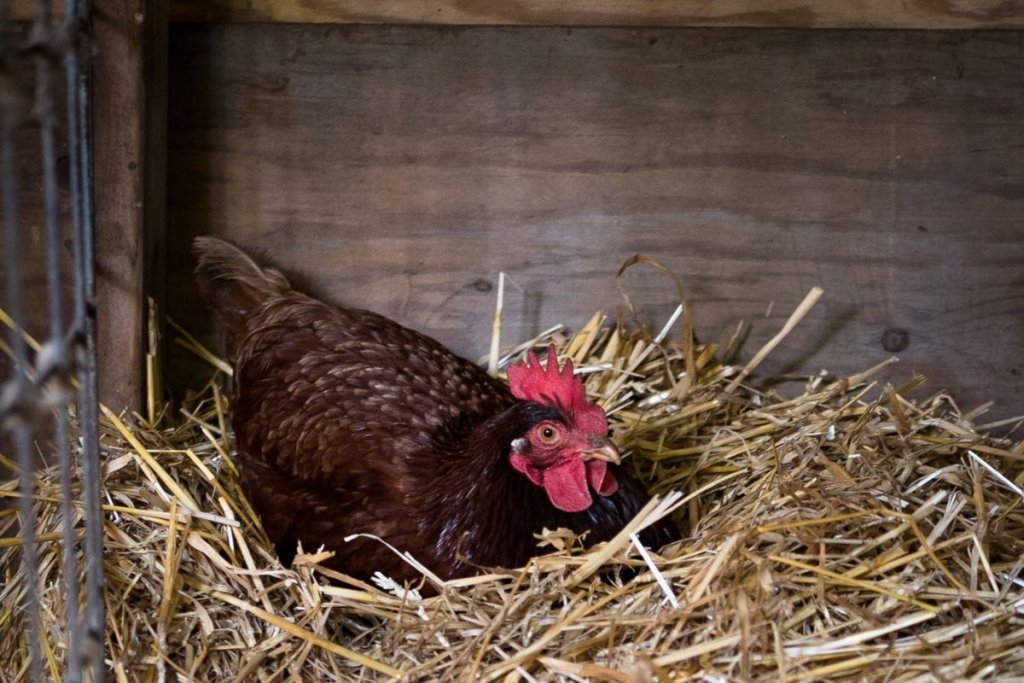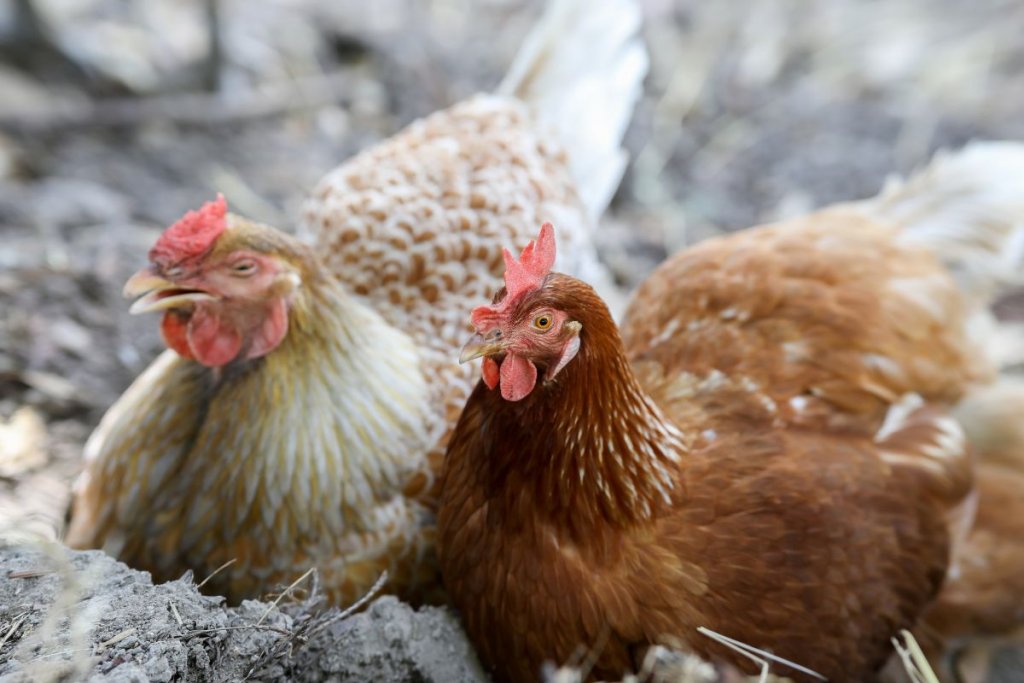You can tell your chicken is egg bound as they remain in the seated position while appearing miserable and overwhelmed. Treatment usually requires rehydrating your chook, heating their back and as a last resort, manually removing the egg.
In a perfect world, you wouldn’t want your backyard chickens to live full lives without diseases or complications. But we don’t always get what we want, and a beloved hen may become egg-bound someday.
You possibly haven’t had to deal with an egg bound chicken. It isn’t a walk in the park getting your egg bound hen back on her feet and in good moods.
This article explores egg binding in chickens to unravel this rare, life-threatening chicken complication. Let’s get started!
Table of Contents
What is Egg Binding?
Egg binding is a complication in hens where a hen has an egg stuck inside her oviduct. An egg bound chicken is a hen with an egg physically stuck in her oviduct.
Instead of carrying through the reproductive tract to complete laying, the egg gets stuck, usually between the hen’s uterus or shell gland and the cloaca.
Dangers Faced by an Egg Bound Hen
An unlucky egg-laying hen that suffers egg binding faces the following dangers:
- Bleeding
- Prolapsed uterus or vent prolapse
- Death, especially if she gets an infection or can’t poop in 24-48 hours
- Infections, such as egg yolk peritonitis sustained if the egg breaks inside the reproductive tract and provides a breeding ground for harmful bacteria.
Causes of Egg Binding
Egg binding in a hen can be caused by any or a combination of the following aspects.
- Genetics (such as belonging to a prolific layer breed or small-sized bird species)
- Physical deformity in the reproductive tract
- Extreme dehydration
- Prolific egg production (Prolific layers like Golden Comet chicken are more vulnerable since laying eggs heavily wears down the reproductive system).
- Old age (Older laying hens are vulnerable to reproductive complications because of weaknesses in their muscles)
- First-time laying (Pullets that recently reach the egg-laying stage may have complications before their reproductive system fully adapts to egg production)
- Obesity
- Infections in the oviduct, which cause inflammations that cause the oviduct to become too narrow
- Too much protein
- Poor diet, causing protein or calcium deficiency
- Laying large eggs or oddly shaped eggs, yet the oviduct can’t overstretch
- Laying double yolk eggs that are usually larger
- Sedentary lifestyles and lack of exercise
- Egg retention or holding eggs (happens when a hen holds the egg while waiting for the perfect laying moment, such as when she is not in danger or when a nest box is available).
- Extreme internal parasite infestations
- Premature laying before the reproductive system is fully developed.
Symptoms of an Egg Bound Chicken
Below are signs and symptoms that your hen may be battling a stuck egg. The symptoms may overlap with symptoms for other conditions that affect chicken health, so it’s prudent to ascertain that you have made the correct diagnosis.

- General weakness (this is still common with other complications)
- Shaky wings, usually because trying to push the egg through drains the hen’s energy
- Swollen cloaca region
- One or both legs appear lame as the stuck egg puts pressure on nerves in the pelvis.
- Penguin posture
- Waddling, instead of normal walking
- Sudden sitting behavior as she tries to free up the egg
- Squawking in distress inside the nest box
- Constipation, especially in smaller chicken breeds, as the egg interferes with normal defecation.
- Very wet feces (or no poop at all)
- Abdominal straining as the hen tries to force the egg out
- Panting (quicker, short breathing)
- Keeping to themselves or showing zero interest in moving
- Loss of appetite
- Tail pumping – up and down tail movement as she tires to unstick the egg
How to Treat an Egg Bound Chicken
If you already have an egg bound chicken in your backyard flock, you’ll first want to know how to treat it before learning how to prevent the complication.
As noted earlier, an egg bound hen has only about 24-48 hours to live. It will likely die if it can’t poop or expel the egg within this timeframe.

First, ensure your chicken is indeed egg bound. Wear a latex glove, then apply some KY jelly on one finger for lubrication. Insert the lubricated finger into the hen’s vent and push it about two inches inside. If you feel the egg, she is egg bound.
For the best results, you will have to combine different treatments. Below are some ways to treat an egg bound chicken.
1. Rehydrating the Chicken with Electrolytes
We’ve already seen that dehydration is one of the causes of egg binding. You can help your hen release the egg by rehydrating her with water or electrolytes administered with a syringe if she has lost her appetite and won’t drink water on her own.
2. A Warm Bath with Epsom Salts and Supplementation with Calcium
A common and effective way to correct egg binding is to give the hen a warm bath with Epsom salts and provide some calcium. Calcium helps with the contraction of muscles, which helps release the stuck egg.
Give your hen some calcium in the form of a calcium supplement, ground oyster shell, or powdered calcium pills.
Fetch a basin to prepare the warm water bath in by mixing about eight cups of hot water with one cup of Epsom salts to a depth of 3-4 inches. The hen should be able to sit in the water comfortably at that depth.
Put the egg bound chicken gently into the warm water and make her sit in it for 15-20 minutes. The salted warm water soothes the muscles to ease the release of the egg.
Use a towel or hair dryer to dry the hen once you get her out of the water. Put her in a warm, quiet, and dark place to let her lay the egg.
To further help her lay the stuck egg, you can soothe the vent by applying some KY jelly, vegetable oil, Vaseline, or olive oil for lubrication.
You can also massage the hen gently from the front to the back to make the oviduct contract. Take care not to rub hard, which would cause the egg to break inside her.
You might have to repeat the warm water bath treatment, lubrication, and gentle massaging 3-4 times in a span of several hours to try expelling the egg.
3. Manually Removing the Egg
If your hen still has the egg stuck, you can remove it manually. This should be a last resort line of action. Have your vet do it or only do it yourself if you can’t afford a vet or can’t get to one in good time.
Before starting the procedure, ensure the egg is visible at the vent. If it’s not visible, lubricate the cloaca and vent area well before trying manual manipulation through massaging.
If the egg is visible, use a (needle-less) syringe to gently puncture a hole through the shell to suck out the contents of the egg to make it shrink.
After sucking the contents out, gently pull out the egg shell while taking care not to break it. You must remove all the shells manually if the egg shell breaks. The removal helps avoid cutting the oviduct and causing infections.
If the egg breaks inside the hen, you’ll have to find a veterinarian to administer antibiotics to prevent infection.
After removing the egg successfully, put the hen in a secluded place for a few hours and observe her keenly.
Make sure she is drinking and eating well and has no excessive redness or vent prolapse before putting her back with the flock, especially if there’s a rooster that may want to mount her.
4. Euthanasia
Sometimes, you have no other option but to mercy-kill an egg bound chicken. This is a highly controversial topic, and many chicken keepers may disagree.
Proponents of mercy killing prefer it as a way to relieve your animal of pain—a sign of love when egg binding proves untreatable.
How to Prevent Egg Binding
Here’s what to do to prevent egg binding from happening in the first place:
- Avoid using extra or supplemental artificial lights for pullets or laying hens to make them lay faster or more
- Provide a wholesome diet with enough calcium, vitamins, water, and protein
- Provide enough nest boxes in the chicken coop
- Treat your flock for worms if you suspect worm infestation and verify it through samples examined by a vet
- Get rid of older hens by turning them into meat
- Help your chickens exercise through games or throwing them food items to chase in the yard.
Conclusion
Treating an egg bound chicken can be challenging, but you can do it successfully on your own or with a vet’s help to save your hen’s life. Show your chicken some love by preventing egg binding early on before the emergency strikes.

